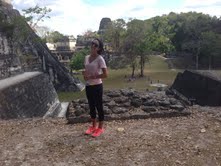Naturally, no trip to Panama would be complete without a visit to the Panama Canal. It was fascinating to learn about the American involvement with the building and maintaining of the canal. The French, fresh from building the Suez Canal in Egypt, started building a waterway to connect the Pacific Ocean with the Atlantic However, they lost some 22,000 technical workers to malaria and yellow fever and spent over $270,000,000 before deciding to hand over the project to the United States. Even with the great U.S. competence and execution, some 5,000 American lives were lost before the project was complete. This feat of engineering has been called one of the seven wonders of the modern world.
Since its inception in 1914, some 900,000 ships have passed through the Canal. Now days, 35-40 ships pass through the canal daily providing Panama with rich royalties that make up a significant portion of the country’s GDP. Some ten thousand people work at the canal keeping it running each day. From practical pilots - highest paid Panamanians, who jump onto an incoming ships before passing through the canal - to direct it through to the mechanics trying to maintain the ever working canal, people are busy at work 24/7.
Old Panama City was subject of Dutch and British pirate attacks. Panama Vieja was the first Spanish outpost on the Pacific coast but was burned down immediately before one of those attacks by the famous pirate Morgan. The most precious item that remains is San Jose, a gold alter, which was painted and covered with mud to be saved. It now rests in Casco Vieja, a newer old town that was built to replace the burned one. Casco Vieja is going through restoration, no doubt it will be beautiful when it's done - with its Simon Bolivar and Independence squares.
Panama City has the most beautiful skyline with tall, modern buildings - a low tax place, apparently, great for retirement. We loved the food, specially at Maito and were excited to head home, back to sweet home, USA.





















